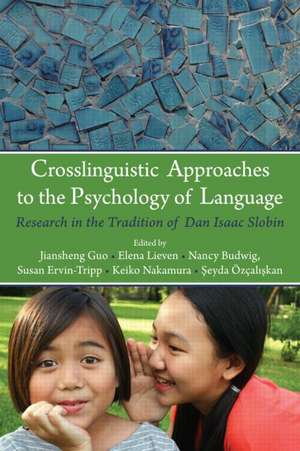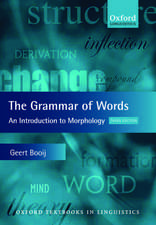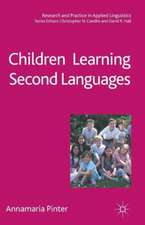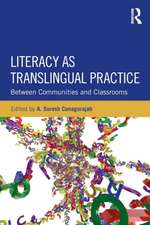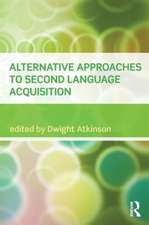Crosslinguistic Approaches to the Psychology of Language: Research in the Tradition of Dan Isaac Slobin: Psychology Press Festschrift Series
Editat de Jiansheng Guo, Elena Lieven, Nancy Budwig, Susan Ervin-Tripp, Keiko Nakamura, Seyda Ozcaliskanen Limba Engleză Paperback – 22 dec 2008
Slobin has insisted on a rigorous, crosslinguistic approach in his attempt to identify universal developmental patterns in language learning, to explore the effects of particular types of languages on psycholinguistic processes, to determine the extent to which universals of language and language behavior are determined by modality (vocal/auditory vs. manual/visual) and, finally, to investigate the relation between linguistic and cognitive processes.
In this volume, researchers take up the challenge of the differences between languages to forward research in four major areas with which Slobin has been concerned throughout his career: language learning in crosslinguistic perspective (spoken and sign languages); the integration of language specific factors in narrative skill; theoretical issues in typology, language development and language change; and the relationship between language and cognition.
All chapters are written by leading researchers currently working in these fields, who are Slobin's colleagues, collaborators or former students in linguistics, psychology, anthropology, and cognitive science. Each section starts with an introductory chapter that connects the themes of the chapters and reviews Slobin's contribution in the context of past research trends and future directions. The whole volume focuses squarely on the central argument: universals of human language and of its development are embodied and revealed in its diverse manifestations and utilization.
Crosslinguistic Approaches to the Study of Language is a key resource for those interested in the range of differences between languages and how this impacts on learning, cognition and language change, and a tribute to Dan Slobin's momentous contribution to the field.
| Toate formatele și edițiile | Preț | Express |
|---|---|---|
| Paperback (1) | 803.76 lei 6-8 săpt. | |
| Taylor & Francis – 22 dec 2008 | 803.76 lei 6-8 săpt. | |
| Hardback (1) | 1572.45 lei 6-8 săpt. | |
| Taylor & Francis – 22 dec 2008 | 1572.45 lei 6-8 săpt. |
Preț: 803.76 lei
Preț vechi: 980.21 lei
-18% Nou
Puncte Express: 1206
Preț estimativ în valută:
153.80€ • 161.03$ • 127.57£
153.80€ • 161.03$ • 127.57£
Carte tipărită la comandă
Livrare economică 10-24 aprilie
Preluare comenzi: 021 569.72.76
Specificații
ISBN-13: 9780805859997
ISBN-10: 0805859993
Pagini: 616
Ilustrații: 80 tables
Dimensiuni: 178 x 254 x 30 mm
Greutate: 1.07 kg
Ediția:1
Editura: Taylor & Francis
Colecția Psychology Press
Seria Psychology Press Festschrift Series
Locul publicării:Oxford, United Kingdom
ISBN-10: 0805859993
Pagini: 616
Ilustrații: 80 tables
Dimensiuni: 178 x 254 x 30 mm
Greutate: 1.07 kg
Ediția:1
Editura: Taylor & Francis
Colecția Psychology Press
Seria Psychology Press Festschrift Series
Locul publicării:Oxford, United Kingdom
Cuprins
J. Guo, E. Lieven, Introduction. Section 1. Language Learning in Crosslinguistic Perspective. N. Budwig, S. Ervin-Tripp, Introduction. J.B. Gleason, B. Phillips, R. Ely, E. Zaretsky, Alligators All Around: The Acquisition of Animal Terms in English and Russian. S. Goldin-Meadow, A. Özyürek, B. Sancar, C. Mylander, Making Language Around the Globe: A Cross-Linguistic Study of Homesign in the United States, China, and Turkey. A. Kyratzis, "He take one my tools!" vs. "I’m building": Transitivity and the Grammar of Accusing, Commanding, and Perspective-Sharing in Toddler’s Peer Disputes. H. Behrens, Direction and Perspective in German Child Language. R.M. Weist, One-to-One Mapping of Temporal and Spatial Relations. A.C. Küntay, D. Koçbas, Effects of Lexical Items and Construction Types in English and Turkish Character Introductions in Elicited Narrative. K. Demuth, D. Ellis, Revisiting the Acquisition of Sesotho Noun Class Prefixes. P.M. Clancy, Dialogic Priming and the Acquisition of Argument Marking in Korean. Section 2. Narratives and Their Development: Linguistic, Cognitive, and Pragmatic Perspectives. R.A. Berman, Introduction. M. Bamberg, Sequencing Events in Time or Sequencing Events in Storytelling? From Cognition to Discourse—With Frogs Paving the Way. E.L. Bavin, Plot and Evaluation: Warlpiri Children’s Frog Stories. R.A. Berman, B. Nir-Sagiv, Clause Packaging in Narratives: A Crosslinguistic Developmental Study. R. Berthele, The Many Ways to Search for a Frog Story: On Fieldworker's Troubles Collecting Spatial Language Data. L. de León, Between Frogs and Black Winged-Monkeys: Orality, Evidentials, and Authorship in Tzotzil (Mayan) Children’s Narratives. J. Guo, L. Chen, Learning to Express Motion in Narratives by Mandarin-Speaking Children. M. Hickmann, H. Hendriks, C. Champaud, Typological Constraints on Motion in French and English Child Language. K. Nakamura, Language and Affect: Japanese Children’s Use of Evaluative Expressions in Narratives. A. Nicolopoulou, Rethinking Character Representation and Its Development in Children’s Narratives. K. Oh, Motion Events in English and Korean Fictional Writings and Translations. S. Özçaliskan, Learning to Talk about Spatial Motion in Language-Specific Ways. E. Veneziano, L. Albert, S. Martin, Learning to Tell a Story of False Belief: A Study of French-Speaking Children. Section 3. Theoretical Perspectives on Language Development, Language Change and Typology. E. Lieven, Introduction. T. Givón, S. Savage Rumbaugh, Can Apes Learn Grammar? A Short Detour into Language Evolution. R.D. Van Valin, Jr., Some Remarks on Universal Grammar. T.G. Bever, The Canonical Form Constraint: Language Acquisition via a General Theory of Learning. W. Klein, Finiteness, Universal Grammar and the Language Faculty. J. Bybee, Grammaticization: Implications for a Theory of Language. E. Sweetser, What Does It Mean to Compare Language and Gesture? Modalities and Contrasts. M. Rispoli, On Paradigms, Principles and Predictions. L. Menn, Child Language, Aphasia, and General Psycholinguistics. L. Talmy, Main Verb Properties and Equipollent Framing. I.I. Antuñano, Path Salience in Motion Events. A. Kopecka, Continuity and Change in the Representation of Motion Events in French. W. Sampaio, C. Sinha, V. da Silva Sinha, Mixing and Mapping: Motion, Path and Manner in Amondawa. Section 4. Language and Cognition: Universals and Typological Comparisons. M. Bowerman, Introduction. P. Brown, S.C. Levinson, Language as Mind Tools: Learning How to Think Through Speaking. D. Gentner, M. Bowerman, Why Some Spatial Semantic Categories Are Harder to Learn than Others: The Typological Prevalence Hypothesis. L. Verhoeven, A. Vermeer, Cognitive Predictors of Children’s First and Second Language Proficiency. S. Pourcel, Relativistic Application of Thinking for Speaking. S. Strömqvist, K. Holmqvist, R. Andersson, Thinking for Speaking and Channeling of Attention—A Case for Eye-Tracking Research. D. McNeill, Imagery for Speaking. A. Aksu-Koç, Evidentials: An Interface between Linguistic and Conceptual Development. S. Stoll, B. Bickel, How Deep Are Differences in Referential Density? Appendix A. D.I. Slobin, Dan Slobin’s Mentors, Models, Influences and Connections: A Self-Portrait (PowerPoint Slides Presented by Dan Slobin at the Special Symposium in His Honor at the 10th International Congress for the Study of Child Language, Berlin, July 2005). Appendix B. Bibliography of Publications by Dan Isaac Slobin.
Notă biografică
Guo, Jiansheng; Lieven, Elena; Budwig, Nancy; Ervin-Tripp, Susan; Nakamura, Keiko; Ozcaliskan, Seyda
Descriere
Inspired by the pioneering work of Dan Slobin, this volume discusses language learning from a crosslinguistic perspective, integrates language specific factors in narrative skill, covers the major theoretical issues, and explores the relationship between language and cognition.
